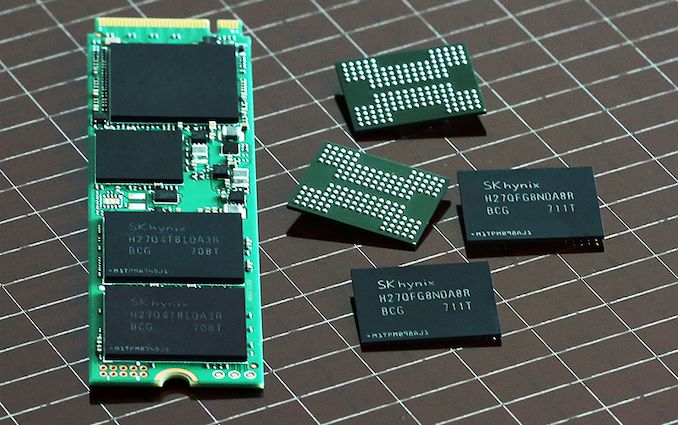SK Hynix NAND Update: 3D NAND Output Cut, Slowdown Capacity Expansions
by Anton Shilov on July 26, 2019 2:00 PM EST
SK Hynix said that it would cut wafer starts of 3D NAND in the coming months more aggressively than it originally anticipated earlier this year. Besides, the company will reconsider plans to equip its M15 and M16 fabs, which will reduce its capital expenditures.
Oversupply of 3D NAND memory encourages makers of flash to reduce their output in a bid to stabilize prices. Earlier this year SK Hynix said that it would reduce 3D NAND wafer starts by 10% in 2019, but this week it said it had changed its plans and now intends to reduce wafer starts by 15% when compared to its 2018 output.
In Q2 2019, SK Hynix’s NAND flash bit shipments increased by a whopping 40% quarter-over-quarter as the company ramped up production of 72-layer 3D NAND and because overall increased demand following a traditionally slow first quarter. Meanwhile, average selling prices of 3D NAND dropped by 25%, which is reason for concern for SK Hynix.
As SK Hynix (and other makers of NAND flash) transitions to more advanced 3D NAND designs with more layers (or more bits per cell in case of 3D QLC) and higher bit density, they increase their bit output, which to some degree create oversupply. As a result, cutting output of (usually previous-generation) wafers by 10% to 15% may not be enough to reduce bit output.
SK Hynix currently produces 72-layer 3D NAND for datacenter and mainstream SSDs. The company’s 512 Gb 96-layer 3D TLC NAND entered production last November and the company intends to increase production of 96-layer 3D NAND shortly. In addition, SK Hynix recently started to ramp up production of 1 Tb ‘4D’ TLC NAND featuring the company’s charge trap flash (CTF) design featuring the peripheral under cells (PUC) architecture. These memory devices promise to significantly improve bit density over currently shipping 3D NAND, and further increase SK Hynix’s 3D NAND bit output.
In addition to reduction of 3D NAND wafer starts, SK Hynix will also slow down expansion of cleanroom space at its M15 fab near Cheongju, South Korea, which can produce both DRAM and 3D NAND. In addition, it will also delay installation of equipment at its M16 fab near Icheon. While SK Hynix does not elaborate, it says that the decision would lower its 2020 CapEx “significantly” when compared to 2019, which may mean that new production capacities at the said plants may not come online next year.
Related Reading:
- Supply of DRAM, NAND & Displays Could Be Disrupted by Japan & South Korea Dispute
- Boom to Bust: Memory Makers Plan to Cut NAND Flash Production
- SK Hynix Set to Build a New Memory Fab
- SK Hynix to Build a New NAND Fab, Upgrade Existing DRAM Fab
- SK Hynix Begins Sampling of 96-Layer 1 Tb 3D QLC NAND
- SK Hynix Starts Production of 128-Layer 4D NAND, 176-Layer Being Developed
Source: SK Hynix










10 Comments
View All Comments
Jimbo123 - Friday, July 26, 2019 - link
Not too long ago, the Korean including Hynix claimed that they will invest $130B in semi fab facilities, see what they saying now.dropme - Friday, July 26, 2019 - link
I believe what they had announced was a commitment for a decade year to come meaning it was for the long run. I don't think they will scrap the commitment anytime soon unless this slowdown continues to the end of the year.James5mith - Friday, July 26, 2019 - link
So wait, the power glitch at Toshiba is supposedly going to lead to a shortage of supply of raw NAND, but all the other companies are deciding to cut production as well?This straight up sounds like yet another price fixing collusion.
It seems to happen about every 10 years or so in the memory business.
Billy Tallis - Friday, July 26, 2019 - link
It's not price fixing. It's just that all of these companies are reacting to the same market forces. The 64-layer node went really well for most companies, so supply outstripped demand and prices crashed. Now everybody's struggling to make enough profit to fund R&D beyond 96 layers, and it's starting to look like Intel's days in the NAND market are numbered. In those conditions, nobody wants to invest billions in an extra fab if it means the output will have to be sold at cost.deil - Monday, July 29, 2019 - link
and it means that no new 192 layers or other magic things ssd's will appear soon, and R&D will focus on cheaper instead of bigger. End users will still win.dropme - Friday, July 26, 2019 - link
I just read a news that DRAM price has by risen 20%. I'm not sure whether Hynix is being greedy or the earlier news is misleading piece.wumpus - Saturday, July 27, 2019 - link
Nearly all the good information is behind paywalls, but I found this:https://www.dramexchange.com/
The DXI graph appears to show a ~10% spike around 7/8, followed by a return to steady reductions in price. The dropping prices of contracts show that the real insiders expect price deceases as well (but I can't get much info at all out of the non-paywall bits).
dropme - Saturday, July 27, 2019 - link
So is it safe to say that the price isn't really bouncing back? Man, at this point I have to wonder how did the three DRAM makers manage to get away with their extortion in the past couple of years.